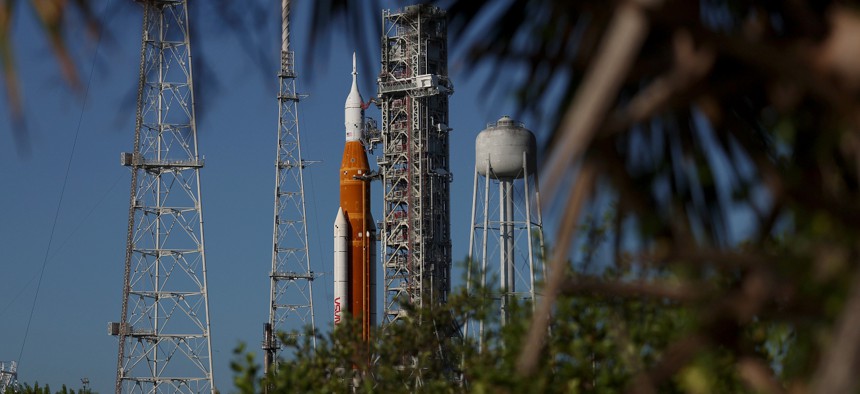
The Artemis mission has already faced multiple setbacks as its first unmanned rocket designed to orbit the moon had to twice delay its launch. Joe Raedle/Getty Images
A Space Workforce Initiative Launches Amid Concerns NASA Has Insufficient Staffing for Artemis Moon Missions
NASA first identified its failure to plan for its workforce needs over the long term in 2016, but has yet to address the issue.
NASA has plans to send astronauts back to the moon as soon as 2025 but may lack the expertise in its workforce necessary to make that happen, according to a new report released just as the White House unveiled an initiative to draw more young people into the space workforce.
The Artemis mission has already faced multiple setbacks as its first unmanned rocket designed to orbit the moon had to twice delay its launch, but the Government Accountability Office warned in a new report it could also encounter long-term issues if it fails to address potential staffing shortfalls. NASA lacks strategic guidance and workforce planning for Artemis as a whole, GAO said, and is not looking far enough into the future to support what the program will need. The agency has only planned five years out, though it already has signed contracts worth $30 billion to support more than a dozen Artemis launches that will stretch well into the 2030s.
Various NASA directorate and facility leaders told GAO the agency has not set specific goals for each office, making it difficult to plan out their staffing needs. Uncertainty in the budget and administration priorities has also hampered efforts, they said. GAO advised NASA to set more specific goals for each Artemis launch “to determine the number and skillset of the required workforce.”
“Completing and implementing long-term workforce planning guidance will be important as NASA embarks on its goals to return humans to the moon and Mars—goals that will require a workforce to execute this set of complex, multi-program missions worth billions of dollars into the next decade,” GAO said.
NASA first identified its failure to plan for its workforce needs over the long term in 2016, but has yet to address the issue. In May, however, NASA gave each mission directorate a fall deadline to come up with short, medium and long-term forecasts for workforce needs.
About one-in-four NASA employees are currently eligible to retire. Centers indicated that potential retirements “create a risk to their workforce due to concerns over the loss of technical expertise without adequately transferring knowledge to newer employees.”
Some locations expect a “wave of retirements” after the Artemis I mission launch, leading to significant technical skill and experience walking out of the door. The Artemis program—which ultimately will build a lunar base where astronauts will live, work and train to go to Mars—is more complex than any previous human space flight initiative, according to NASA’s own internal reporting, creating additional risks. The agency told GAO it hoped younger employees knowledgeable in new technologies such as machine learning and artificial intelligence would help offset other gaps or losses.
GAO also noted NASA is facing far greater competition from the commercial space industry than ever before and the agency often “has difficulty offering the salary and benefits the private sector is providing.” Officials said NASA still has a reputational advantage and can still leverage employees in the private sector through its ongoing partnerships with those companies. GAO cautioned that change in NASA’s approach—relying more on companies like SpaceX and Blue Origin—will require the agency to rethink its workforce’s structure.
“While NASA has historically relied on a workforce with specialized technical expertise and systems engineering skills to build space systems and manage programs, changes to acquisition approaches mean that NASA will need a workforce with the skills to oversee commercial contracts while retaining technical expertise,” GAO said.
NASA agreed with GAO’s recommendations and vowed to develop a more complete workforce plan by September 2023. The agency has tentatively rescheduled the Artemis I launch for later this month.
The White House on Friday announced a plan to help NASA and other agencies in the long term, releasing the Interagency Roadmap to Support Space-Related STEM Education and Workforce. The administration has tasked agencies with utilizing their resources to inspire individuals to pursue careers in space-related work and has created a guide for educators to demonstrate to students the type of space-related jobs available throughout the federal government. The guide showcases the work specific employees are doing at the Energy Department, U.S. Geological Service, National Science Foundation, Federal Aviation Administration, Agriculture Department, National Oceanic and Atmospheric Administration and NASA. The space agency is awarding $4 million to various institutions to build students' interest in Artemis and other space programs, while an array of private sector companies are also partnering with the Biden administration to grow interest in space-related careers.
Vice President Kamala Harris, who chairs the National Space Council, announced the initiative on Friday at the Johnson Space Center in Houston. Harris lamented that thousands of space-related jobs requiring technical skills are sitting vacant, but lauded the private sector for their efforts to train workers to fill those positions.







